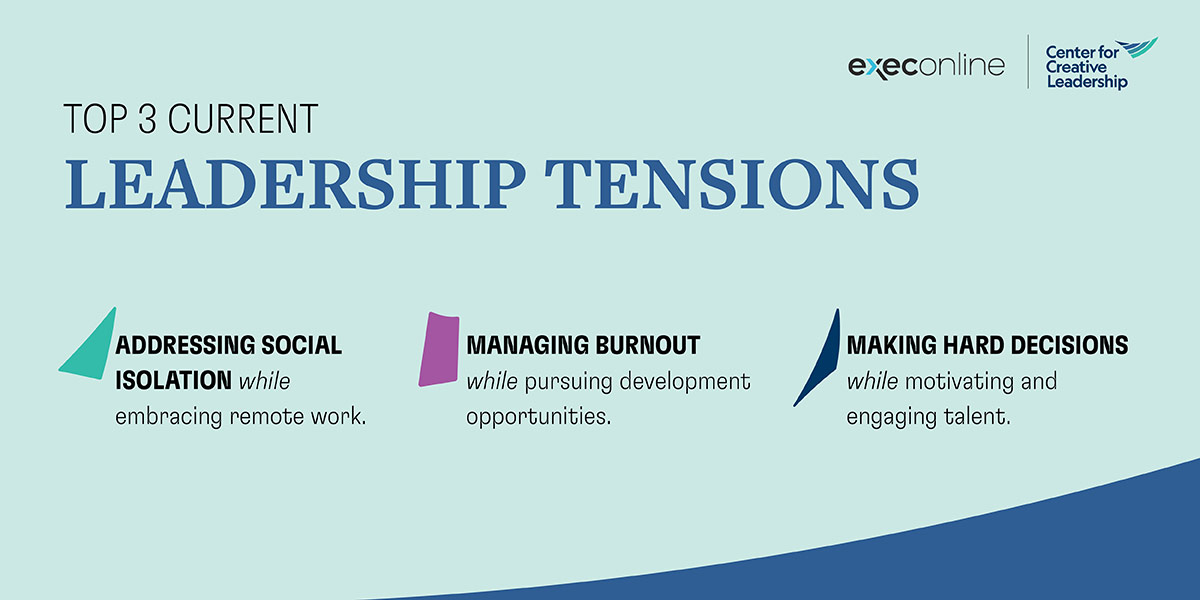Leadership tensions are an abundant and unfortunate reality for most managers in today’s workforce. From constantly shifting expectations to demanding external and organizational pressures, those in leadership positions face a unique set of challenges that require special attention and intentional effort to resolve.
In partnership with ExecOnline, we conducted a research study on today’s top leadership tensions by surveying more than 43,000 people currently in managerial roles. Together we identified 3 primary tensions facing the majority of workplace leaders, as well as steps organizations and people leaders can take to alleviate and navigate them.
This research fits into our continuing effort to understand the challenges faced and competencies needed by those in leadership and provide organizations with tools to equip their people to balance leadership tensions, prioritize resources, and manage conflicting demands. By understanding the core leadership tensions that today’s managers are grappling with, your organization can improve retention and overall performance.
Regardless of industry or geography, the majority of leaders we surveyed find themselves in a bind. In addition to focusing on their own personal development, managers are tasked with the needs of direct reports and team members who depend on them for guidance and support. Add to that external factors such as economic uncertainty, technological shifts, the rise of hybrid work, and the ongoing recovery from a global pandemic, and it’s clear that leaders today are facing new and daunting challenges that they need support to resolve.
What Are the 3 Key Leadership Tensions?
Leadership Tension 1: Addressing Social Isolation While Embracing Remote Work
Though it’s widely believed that people leaders are particularly motivated to return to office settings, 99% of those we surveyed who work virtually at least part of the time reported that they’ve found remote work offers several benefits that working in an office doesn’t. For instance, 75% of leaders reported appreciation for additional time available through avoiding long commutes, and 56% pointed to flexibility as a key advantage. Leaders also recognized other organizational benefits, especially related to attracting and retaining talent with a broader talent pool.
Although many prefer remote work, the arrangement also often leads to social isolation. Most leaders in our study reported increased difficulty building relationships with coworkers, and agreed that reduced social and professional interactions have caused strain. Feelings of isolation can negatively affect peer-to-peer and peer-to-supervisor relationships.
That’s why finding a way to embrace the benefits of remote work while also addressing social isolation is a critical leadership tension faced by today’s people managers.
Access Our Webinar!
Watch our webinar, 3 Tensions Facing Workplace Leadership Today, and learn more about the 3 leadership tensions our research uncovered and how organizations must equip their managers to balance them in today’s new world of work.
Leadership Tension 2: Managing Burnout While Pursuing Development Opportunities
The cumulative effects of pandemic stress and its global aftermath have created unprecedented levels of collective exhaustion. A staggering 72% of leaders surveyed reported that they are “at least somewhat” burned out — the 6th successive quarter this figure has been above 70%. Further, nearly half (46%) of those in leadership positions told us they need more resources to be effective at work.
We know that people burn out from a lack of support and resources, conflicting or unclear work tasks, a lack of autonomy, and forced attention on matters that are unimportant. It’s important to note that the quality of relationships (or lack of them) in the workplace is also directly connected to burnout, adding an additional level of risk of exhaustion and overwork for those working virtually or in a hybrid arrangement. These elements, especially combined together over long periods of time, can lead to sustained burnout that’s difficult to overcome.
When leaders experience burnout, they struggle to find a place for growth and development in their already-hectic schedules, and they have a hard time learning, or being able to absorb and apply the things they do learn. Yet when asked what would help them be more effective in their roles, 41% of leaders reported that they desired more leadership and development opportunities than they currently receive. It’s a major challenge to fit in professional development and work toward career advancement when you’re already struggling just to manage or prevent burnout.
Organizations must look for ways to support their people leaders in spending time on growth and development opportunities while also fending off burnout.
Leadership Tension 3: Making Hard Decisions While Motivating and Engaging Talent
For organizations to thrive despite economic uncertainty (including the possibility of a recession), leaders must be able to effectively manage conflicting job demands and show strategic leadership by prioritizing resources.
Recent economic volatility and the many workplace changes relating to the global pandemic have caused managers to face heavier workloads — along with fewer personnel and resources. In fact, the top 2 responses in our survey that leaders noted as their biggest challenges in the current work environment were managing more work with smaller teams and boosting employee engagement and motivation without monetary incentives. Also, any financial incentives that leaders do have at their disposal are less effective motivational tools, due to persistent inflation.
That’s why a 3rd key leadership tension that today’s managers face is becoming skilled motivators of talent who can engage and retain their employees while also making tough decisions using limited resources.
How to Resolve These 3 Leadership Tensions
Recommended Strategies for Organizations
1. Address Social Isolation While Embracing Remote Work.
One way to enable people to move past feelings of isolation is to provide ample opportunities to enhance human connection. Facilitate chances for those who don’t interact with each other on a daily basis to discover shared interests and commonalities through working together. Be intentional about enabling social interaction through more cross-functional projects, working groups, breakout sessions during organization-wide meetings, and events like “lunch and learn” presentations open to all employees. Create virtual spaces for connection, such as coffee breaks and water cooler chats, to create opportunities for connecting on both work and non-work-related topics.
Development can play a role, too. Make sure people leaders are trained to be empathetic, show compassionate leadership, and create an inclusive work environment. Consider offering development specifically aimed at improving virtual communication effectiveness and work to build conversational skills across the organization. In addition, group or team coaching can assist with bringing leaders together to work toward a common goal and encourage better communication and collaboration.
Lastly, look for opportunities to build connections among remote teams, and facilitate as many opportunities as possible for real-time, synchronous collaboration. Research has shown that teams who take advantage of real-time technology, such as video meetings and instant messaging/chat, have a much greater connection to each other and the work they are doing. You’ll want to leverage technology thoughtfully to facilitate effective virtual collaboration, and be intentional about selecting the right technological tools and setting clear expectations for their use. Encourage leaders to establish team norms and work with team members to agree on appropriate cadences and platforms for check-ins, brainstorming sessions, and virtual social events.
These steps will help balance the leadership tension between embracing the benefits of remote work and the accompanying social isolation, loneliness, and disconnection it can bring — all while your organization improves retention through embracing flexible work arrangements.
2. Manage Burnout While Pursuing Development Opportunities.
To support today’s stretched-thin leaders, organizations must focus on providing development opportunities that mitigate burnout — or at least avoid increasing it further. This means training must be easy to access and fit into busy schedules, and should help leaders who are dealing with burnout to heal from it and alleviate its effects, while also growing needed skills.
For example, virtual leadership development programs are an effective way to provide leaders with access to learning at their own pace, without the hassle and expense of travel. Furthermore, those we surveyed reported that virtual programming, shorter modules, and on-demand options among the top reasons that would enable and encourage them to participate in learning opportunities. Leaders who put in the effort to offer professional development that meets these criteria enable exhausted individuals a chance to turn away from their daily work to focus on putting energy into reflection, growth, and self-improvement. This is way that organizations can help mitigate work-life conflicts among their employees.
Similarly, one-on-one coaching can improve performance and show support, providing a way for organizations to enable their talent to prioritize development and bring their best selves to work, while focusing on the participant’s individual needs, values, and challenges. The combination of coaching and mentoring with tailored professional development can enhance personal growth while also reinforcing learning and trying out new mindsets and behaviors — ultimately helping leaders to build their leadership skills and resilience.
To address this leadership tension, organizations should be intentional about creating an environment of support, and treat managing burnout not just as an outcome of development, but as a learning objective for development in its own right.
3. Make Hard Decisions While Motivating and Engaging Talent.
Given the impact of economic uncertainty, shifting generational expectations, and high employee turnover, organizations need leaders who are skilled at motivating and engaging employees. They must also understand how leadership development powers engagement and retention. Our research found that while a third of leaders are highly proficient at strategic prioritization and talent engagement individually, a meager 9% are highly proficient in both skills. That’s why organizations must focus on leadership development to ensure that their managers are as skilled at strategic decision-making and financial insight as they are at effective communication, showing compassion, and leading hybrid teams.
Our research with ExecOnline also found that when leaders believe their organization prioritizes and invests in their professional development, productivity is 12% higher and retention increases by a whopping 41%. This investment also helps increase people’s ability to take on daily challenges and build meaningful connections in the workplace. These aspects combined have the potential to dramatically increase employee motivation and engagement and improve your organization in a way that attracts and retains future talent, too.
Managers can ease these leadership tensions by prioritizing work tasks for themselves and team members, delegating workloads given the reality of fewer team members, and becoming comfortable making critical business decisions amid organizational uncertainty. And organizations should plan to continue to invest in leadership development even during economic downturns to ensure they’re securing their pipeline of leaders for the future.
To manage the leadership tension of keeping talent engaged while making hard decisions with limited resources, focus on supporting overall employee wellbeing and work to identify ways to motivate people without monetary incentives by building and maintaining and positive culture of inclusion in the workplace.
What These Findings on Leadership Tensions Mean for Leaders and Organizations
Managers in today’s work environment face unique and increasingly difficult challenges. Our findings show that now is the time for leaders and organizations to take the necessary steps to acknowledge and address these 3 key leadership tensions to ensure long-term success. In short, offering cross-functional opportunities for remote workers to connect, investing in professional and personal development while mitigating burnout, and being strategic about the skillsets leaders need is vital for organizations navigating these leadership tensions.
When organizations invest wisely in their people and supply leaders with the right tools to be successful, they can increase employee wellbeing, improve the culture of the organization, and cultivate a competitive edge in an increasingly volatile and unpredictable world.
Ready to Take the Next Step?
Take steps to support your workforce facing these leadership tensions. We can help you foster connections within teams through group coaching and reinforce learning by pairing training with one-on-one coaching.











